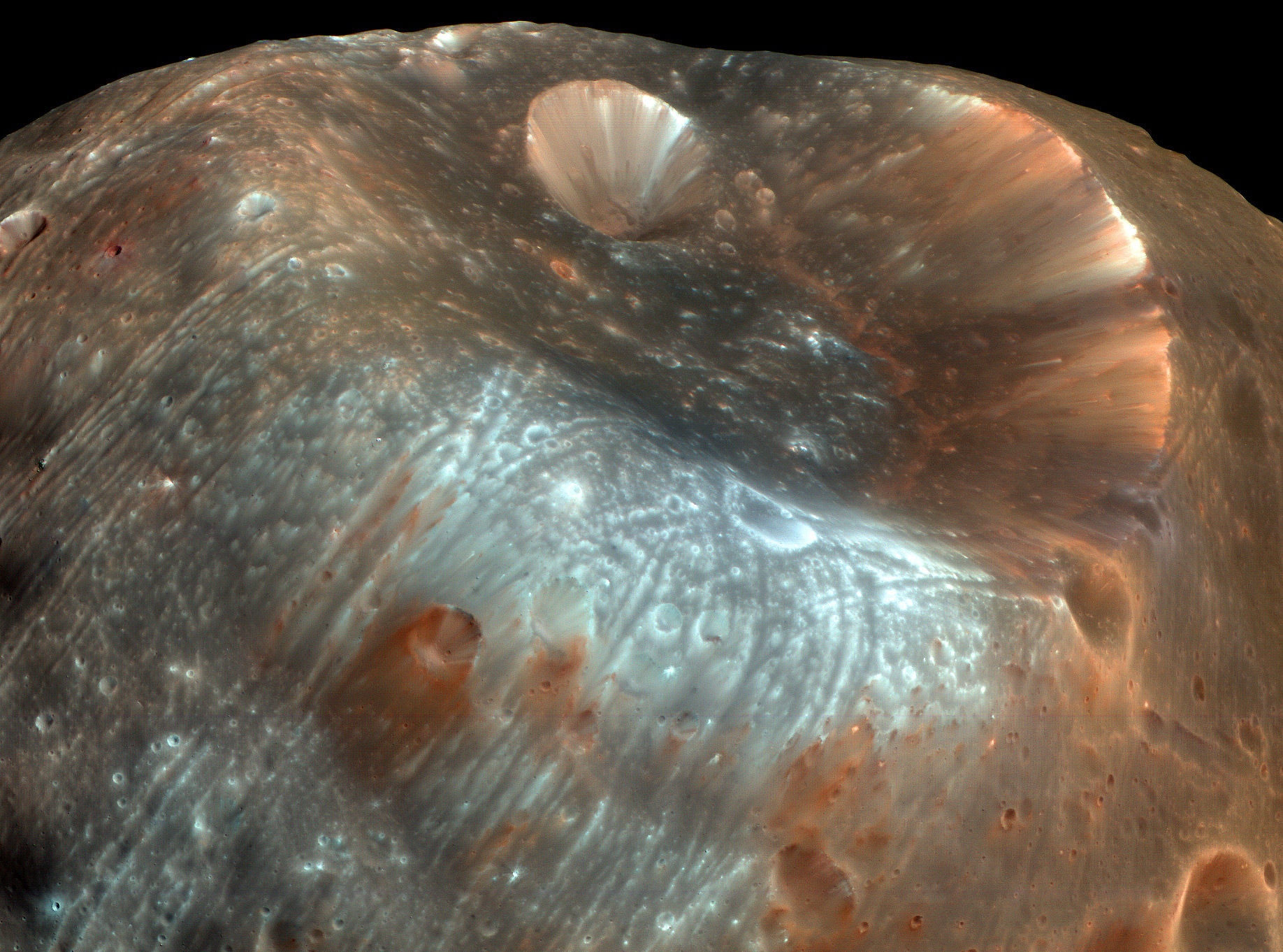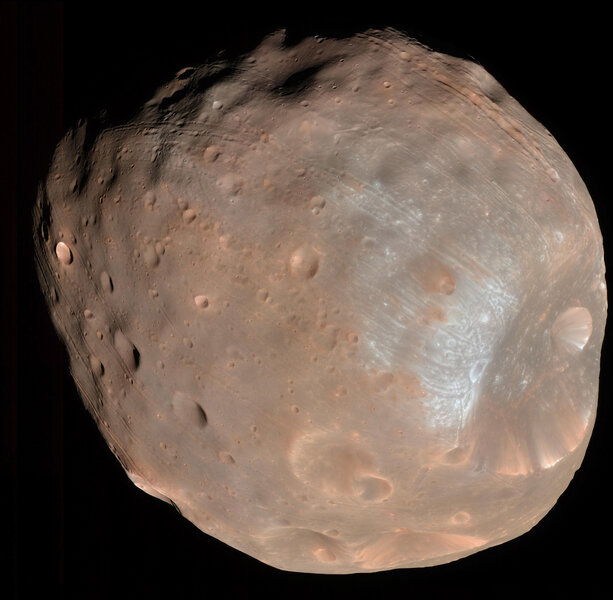Create a free profile to get unlimited access to exclusive videos, sweepstakes, and more!
How Phobos got its grooves

Mars has two moons, Phobos and Deimos. Both are small — about 22 and 12 kilometers across on average, respectively — and cataloguing their individual weirdnesses would be a blog post or three unto themselves.
But Phobos has one set of features that really sticks out… or more accurately, sticks in.
Images taken of Phobos when spacecraft first visited Mars in the 1970s show that the moon is groovy.
Literally! It's covered in long, narrow grooves, some 80 – 200 meters wide, and up to 30 kilometers long. Many — but not all — appear in parallel groups, and some wrap nearly all the way around the small satellite! What the heck are they?
There have been a lot of hypotheses proposed to explain these weird structures, but none has been entirely satisfactory. Some involved gravitational stress from Mars cracking Phobos, or impacts on its surface creating fractures. One even proposed a big asteroid impact on Mars sending up debris in to space, leaving long trails on Phobos as the moon passed through the cloud! They're all clever, but in the end they fall short of explaining all the features seen.
But a new idea has been proposed — based on one of the earliest ideas explaining the grooves, in fact, but substantially modified — that appears to cover everything seen.
It involves the crater Stickney, a massive impact crater on one end of the potato-shaped moon. Stickney is 9 km across… and remember Phobos is only 27 km long across its long axis, so Stickney is far and away the most obvious feature on the moon. Had the impact that created it been much bigger it could've shattered Phobos entirely.
The new idea is that when the impact occurred, it flung lots of boulders up off the surface, some of which were very large (over a kilometer wide). These then rolled over the surface, creating the grooves.
This idea has been proposed before, and it does explain quite a few of the features. For example, a lot of the grooves are obvious pointing away from Stickney, as you'd expect from stuff blasted out.
But there are problems with this! Not all the grooves point away from Stickney; some run at a good angle from it. Also, there are grooves inside Stickney itself, which is hard to explain if it simply threw rocks away. Some grooves cross other grooves, again hard to explain from a simple event flinging rocks out. Another is that if big boulders did all this, where are they now? They should stick out of the surface, but none big enough is seen.
Also, like all moons orbiting their host planets close enough, Phobos is tidally locked, rotating once on its axis for every time it orbits Mars once (our own Moon does the same thing). That means it keeps the same face toward Mars, which in turn means one part of Phobos always points in the direction of its orbit (the leading hemisphere) and one away (the trailing hemisphere). Laputa Regio is an area on the trailing hemisphere, 180° around from Stickney, that's oddly devoid of grooves, a forbidden zone of sorts.
How to explain all this?
The scientists were clever, and kept it simple. We have far more info about Phobos than we did some years ago, including its elevation map, its mass, and other physical characteristics. So what they did was create a model using the physics of what would happen to giant (1,200-meter diameter) boulders flung out from Stickney from an impact, including things like the uneven surface, the change in the surface gravity due to that uneven surface (Phobos is so small and irregularly shaped that how much gravity you feel depends on where you stand on it), its rotation, and even the gravitational influence of Mars. They simply put in all the physics, made no assumptions about what they wanted the outcome to look like, and let things roll.
What they found is astonishing. It neatly explains almost everything!
As you'd expect, groups of boulders ejected from the impact can create the series of parallel grooves. But Phobos has such low gravity that they can roll for a long way, and for a long time. If you add in the rotation of Phobos (about 7.5 hours), that changes the orientation of the surface compared to the initial trajectory of the boulders. Some of them will make a sort of corkscrew pattern over time, which will inevitably cross over grooves emplaced earlier at an angle, just as seen on the surface.
In fact, some could travel for so far that they could go all the way around the moon, crossing over Stickney, their point of origin. That explains the groves seen inside the crater, too.
What about Laputa Regio, the Forbidden Zone? Why are there no grooves there? As it happens, this region is an area of lower than average elevation on the surface. At first blush, you might expect more tracks there, because rocks tend to roll downhill. So why aren't there any at all?
It turns out this depression has a little bit of a raised rim around it. As a rolling boulder approaches Laputa Regio, it rolls over the rim, which acts like a ramp, launching it up over the surface. It literally hops over the lower elevation region, falling back down on the other side.
Evel Knievel would've loved Phobos.
The last part is my favorite: Where are the boulders now? It turns out they're there, but they're buried.
The impact that carved out Stickney was pretty dramatic, and launched a lot of debris away from the moon. Some of that would've gone into orbit around Mars itself. Simulations show that some time later, probably less than 1,000 years, a lot of this stuff re-impacted all over Phobos. This would've done two things: a) It would've slammed into and fractured bigger boulders, cracking them into smaller ones, and 2) the amount of debris falling back would've covered the moon in fine-grained to pebble-sized debris (called regolith) up to a depth of 30 – 50 meters.
Yikes. That's quite a follow-up. But it explains why we don't see the big boulders; they got smashed and then buried. That makes this idea testable: If we send probes (or people) to Phobos and they dig down far enough, they should find these big boulders. That's maybe a little difficult to attempt right now, but at least in principle it's doable.
There's one other thing I found interesting. Phobos orbits Mars very close to the surface, just about 9,400 km up. We know that the orbit is shrinking over time, too, due to gravitational effects from Mars. So the researchers ran these impact simulations using larger numbers for Phobos' orbit, assuming it happened a while in the past, when Phobos was farther from Mars (remembering too that the gravity of Mars affects how the boulders behave once they are blasted out from Stickney).
They found the simulations worked best, matching the groove patterns, for a distance of 12,000 km, which is where Phobos was about 150 million years ago. They didn't test for any orbital size bigger than 14,000 km, so this isn't the last word on it, but it's nifty they can get a guess at the impact date from their models.
So is this idea the last word on the features? Probably not. Certainly more and more detailed models need to be run, ones with more sophisticated physical parameters. And in the end we'd need some predictions to pan out (like the buried boulders) to be more confident this is the actual explanation.
I like it, though. It explains a lot, including stuff other ideas couldn't, and uses basic and solid physics to get the job done.
What else can one do now but quote Bruce Campbell here?
P.S. I really wanted to title this "How Phobos Got Its Back Grooves," but unfortunately its back side is where there's a lack of grooves, so it wouldn't work. <shakes fist angrily at Mars>





























